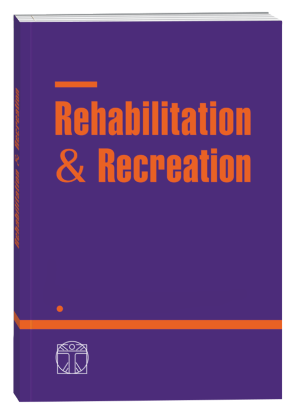PARTICIPATION IN PHYSICAL CULTURE AND HEALTH EDUCATION – SELECTED ISSUES
DOI:
https://doi.org/10.32782/2522-1795.2022.12.22Keywords:
physical culture, health education, physical education, sportAbstract
Making children believe that health is an asset and a value that is worth caring for and striving for, is one of the most important goals of health education. Kindergarten and school play an important role in shaping positive attitudes of children, including those promoting health, and health education should be analyzed as a basic right of every child, which should be included in their preschool and early childhood education. Issues related to health education carried out in educational and upbringing institutions are of interest to a small group of authors. In the available publications, one can notice a specific lack of focus on pre-school and early-school health education issues from a systemic perspective. Therefore, there is a need to attempt to fully comprehend the issues of preschool and early childhood health education, which has been attempted in this study. Health education activities should be started as early as possible, as engaging in quality education in the first years of a child's life is much more effective and brings significant benefits later in life than later interventions. Therefore, bearing in mind its importance, this education cannot be omitted at the stage of pre-school and early school education. In health education, the most important concept, both for theoretical considerations and for practical solutions based on them, is health. The concept of health may be the subject of reflection of at least three sciences: medicine, psychology and sociology. Physical education and sport at school, due to the sports activation of a huge group of children and adolescents, is extremely important in the social and individual dimension. This activity has a direct impact on the physical and mental condition of the young generation. It improves the health of our society and builds habits of physical activity, which is an essential element of our health in every age group. In summary, physical activity and health education are of great importance for health. Avoiding them can lead to disturbances in the functioning of the body, which results in diseases. If we spend our free time actively, it will bring many benefits for us, not only physically, but also mentally, we will better cope with stress.
References
Buczak A. (2016). Edukacja zdrowotna w kształceniu językowym w świetle analizy podstawy programowej i podręczników do nauki języków obcych. Lubelski Rocznik Pedagogiczny, t. 35, z. 3, S. 241.
Fronczek M., Borzęcki P. (2012). Zdrowie i niepełnosprawność – problemy w definiowaniu. Cz. 1. Cechy wykorzystywane w ocenie stanu zdrowia. Journal of Health Sciences, vol. 2, no. 5, S. 87-100.
Grygus I., Jewtuch М. (2013). Wpływ zaproponowanej metodyki wychowania fizycznego na stan funkcjonalny studentów. Journal of Health Sciences. 3(9), 417-426.
Grygus I., Kuczer T. (2013). Optymalizacja poziomu fizycznego zdrowia studentów z uwzględnieniem typu autonomicznego nerwowego systemu. Journal of Health Sciences. Vol. 3. № 6. S. 323–332.
Grygus I., Kuczer T. (2013). Optymalizacja sprawności fizycznej studentów z różnymi rodzajami autonomicznego układu nerwowego. Journal of Health Sciences. Vol. 3. № 10. S. 583–604.
Grygus I., Nesterchuk N., Skalski D., Zabolotna O. (2021). Edukacja w polskim społeczeństwie nowoczesnym a edukacja zdrowotna. Kultura fizyczna, edukacja zdrowotna i bezpieczeństwo. Gdańsk, 81-97.
Hoffmann B. (2002). On the triad disease, illness and sickness. Journal of Medicine and Philosophy, vol. 27, no. 6, S. 651-673.
John-Borys M. (2002). Koncepcja zdrowia i choroby u dorastających. Wydawnictwo Uniwersytetu Śląskiego, Katowice.
Kones.T., Green J. (2004). Health promotion. Planning and strategies. SAGE Publication, London.
Korczak C. Leowski J. (1977). Problemy higieny i ochrony zdrowia. WSiP, Warszawa. S. 23.
Lewicki C. (2006). Edukacja zdrowotna – systemowa analiza zagadnień. Wydawnictwo Uniwersytetu Rzeszowskiego, Rzeszów. S. 14.
Niebrój L. T. (2006). Defining health/ illness: societal and/or clinical medicine? Journal of Physiology and Pharmacology, vol. 57, no. 4, S. 251-262.
Nordenfelt L. (1993). Concepts of health and their consequences for health care. Theoretical Medicine, vol. no. 4, S. 277-286.
Parsons T. (1969). Struktura społeczna a osobowość, tłum. M. Tabin. PWN, Warszawa. 340.
Sigerist H. E. (1941). Medicine and human welfare. Yale University Press, New Haven. 12.
Skalski D.W., Grygus I., Skalska E., Rybak L. (2022). Współczesna kultura fizyczna a styl życia. Spektrum peregrynacji po kulturze fizycznej dla mistrzów wychowania fizycznego: Scientific monograph. Praca zbiorowa pod redakcją Białasa M. i Skalskiego D.W. Gdańsk. 21-34.
Tobiasz-Adamczyk B. (1998). Wybrane elementy socjologii zdrowia i choroby. Wyd. Uniwersytetu Jagiellońskiego, Kraków. 22.
Tones K., Green J. (2004). Health promotion. Planning and strategies. SAGE Publication, London.
Wagner S., Banaszkiewicz M., Andruszkiewicz A., Strahl A., Miler A., Kubica A. (2015). Zachowania zdrowotne i miejsce zdrowia w hierarchii wartości młodzieży. Medycyna Ogólna i Nauki o Zdrowiu, t. 21, nr 3, S. 278-281.
Woynarowska B. (2013). Edukacja zdrowotna. Podręcznik akademicki. PWN, Warszawa. 19.
Zabolotna O., Skalski D., Formela M., Kowalski D., Nesterchuk N., Grygus I. (2019). Rodzina a kultura fizyczna. Socjologiczne aspekty rodziny w kontekście edukacji zdrowotnej. Rehabilitation & recreation. № 4. S. 37-48.
Downloads
Published
How to Cite
Issue
Section
License

This work is licensed under a Creative Commons Attribution-NonCommercial-NoDerivatives 4.0 International License.











